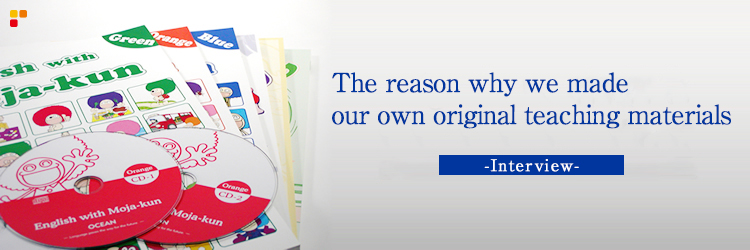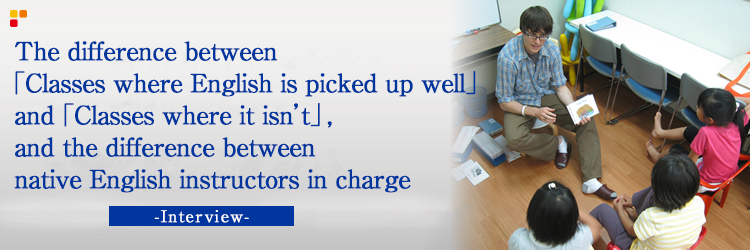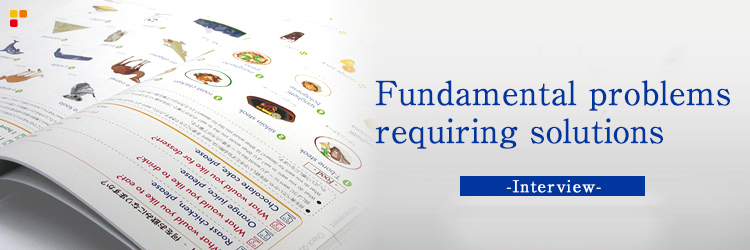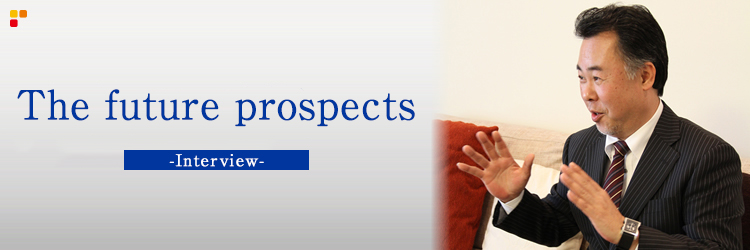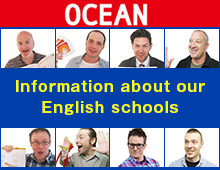Mr Yamamoto : Ocean Global Network dispatches their native English instructors to schools, kindergartens, cram schools and so on in Aichi, Gifu and Mie prefectures, andruns the direct management of the English School as well. You are getting a very good reputation locally at the English schools for children as well. However, why did you decide to make your own original teaching materials in the first place?
Honda : About ten years ago we just dispatched native English instructors. At that time, we had original textbooks for phonics but we used major publisher’s native English textbooks, such as "O" publishing company or "L" publishing company as ourmain textbooks. We combined those published textbooks with our own original curriculum and thoroughly trained our instructors so that the children could enjoy becoming familiar with English. We never received any claims regarding the lessons themselves from our customers but to be honest, I myself experienced a dilemma when Inoticed that students who had been studying English for three or four years didn't achieve the level that we had initially assumed they would."
Yamamoto : "We hear that Ocean's instructors are very good, but is it difficult even for them to raise the achievement level?"

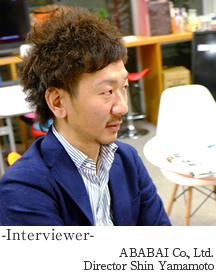
Honda : "Yes. Usually, there is no clear learning motivation for English arising from kindergarten and elementary school students themselves. More often than not, parents consider the future of their children and enroll them in English classes from their feeling that "It would be better if they were able to speak English well in the future."Furthermore, children like to continue coming to school if they enjoy the lessons.Therefore, we used to include a variety of games and activities when we made our lessonplans, just as most other English schools generally do."
Yamamoto :"Yes, that's a common pattern at English schools. What was the problem with that?"

Yamamoto : "That's right. I remember thinking that English was difficult every timethose topics came up when I was a junior high school student. It's really difficultfor native English instructors to make Japanese students understand such topics inEnglish."
Honda : "Exactly. The published materials that we used before are still the most commonly used in Japan today. The textbooks for students feature a lot of pictures butonly a limited amount of necessary English instructions and they don't feature any Japanese instructions at all. Those published textbooks usually have English teachingmanuals which are sold separately. These manuals contain a variety of ideas on "howto introduce English to Japanese children." The methodology itself creates someproblems, but the greater overall problem is the big difference in diligence brought forward by the native instructors. Some serious instructors read the manual properly before hand and then perform the lessons accordingly. But, some do notread through the manual at all and perform lessons in their own way as they deemfit. In other words, as long as we use textbooks that require teaching manuals, it is very difficult to homogenize the lesson quality of the native instructors no matter how much training they have received.
Yamamoto : "I see. So in having a lot of native English instructors like you do at Ocean,when dispatching them to your clients, I guess it's hard to homogenize the performance of the instructors.
Honda :This doesn't just happen to us. This happens to any English school or cramschool that hires native English instructors. The larger the part that a schools relies onnative English instructors for, the easier it is for "Good or bad variation in the reliability of teachers" to manifest. In fact, some of our clients, used to run their English schools bydirectly employing native English instructors but abandoned this approach due tocontinuous problems, and many then decided to switch to our dispatch teacher systeminstead (instructors trained in-house with our own original materials).
Yamamoto : "Is that so. There are some differences in culture and ways of thinking between native English instructors and Japanese people."

Honda : "Of course, there's difference in culture and ways of thinking. At first anyone could be perplexed by that. However companies like us, who have employed native English instructors for a long time, have gotten used to these differences and have acquired the know-how to handle such situations, so this is not such a big problem forus. As I mentioned before, the biggest problem was the homogenization of the lessons ofthe native English instructors."
Yamamoto : "So that is when you decided to make your own original materials."

- Even if children are taught by native English
instructors consistently every week, it's impossible
to learn English naturally in such a limited
timeframe. - Children become familiar with using English as a
result of learning. - There are no short-cuts to learn English. To learn
English, we need to "listen to English a lot and
talk English a lot." - While taking advantage of the benefits of having
native English instructors, it isessential to make
teaching materials that enable children to "listen
a lot, talk a lot". - It is essential to make teaching materials that
don`t require a teacher's manual.
Yamamoto : "I see. Many English schools advertise that children can learn naturally ifthey take lessons with native English instructors. But this is an enduring fantasy. Thusthe lessons, unlike free-conversation lessons for adults, will be for infants andelementary school students so native English instructors will have to follow a set curriculum or materials. This means that the materials themselves are therefore really important."
Honda : "That's right. One time, we were wondering what the difference is betweennative English instructors in charge of Classes where English is picked up well, andClasses where it isn’t. So we investigated the reason for these differences from everypossible angle."
Yamamoto : "That's interesting. And then did you identify the reason?"
Honda : "Yes, there's a difference in native English instructors' character and children'sattitude to learning. However there were some classes in which we weren't satisfiedwith the students' achievement even though bright and energetic instructors who werevery popular with students taught them. So we counted the number of "children'sspeaking time" during the class with a bird watching counter.
Yamamoto : "Did you count the number of times the children spoke with a counter? Andwhat was the result?"

Honda : "We could get clear results. The number of times children spoke in a one hourlesson (usually 50 minutes long) depended largely on the teacher in charge, differentteachers had different numbers – ranging from about 100 to about 300 times. And ofcourse, it became very clear that the classes that had a higher number of words spokenby the children achieved better results. We believed and decided to make teachingmaterials that increase the number of times children speak in a class, and train ournative English teachers to do that."
Yamamoto : "That's a convincing result. By the way, I don't know if the number of 100times or 300 times is sufficient or not, but how many times do children get to speak inclass at an ordinary English school?
Honda : "When we ask native English instructors who come for an interview that havesome experience of working at different English schools to do a demo lesson, theyusually get about 70 to 100 times for the number that students speak. With suchnumbers, there is quite a bit of time where no students are speaking at all in class, likewhen they are working on something, writing without talking, or when the instructortalks a great deal but the students themselves don't talk that much."
Yamamoto : "Is that so?"
Honda : "Of course we've never felt that parents should bring a counter to the classes and count the number of times students speak, but actually at many of the English schools it`s as such. So we got to working on making materials that don’t rely on ateacher’s manual and that can increase the number of times students speak, while simultaneously training the native teachers to have the students speaking in English at least 300 times per class.
Yamamoto : "When I observed some lessons at Ocean, I was very surprised at first. Thepace of the classes was really good and the native English instructors and also the children spoke a lot of English. Now I can really understand the idea behind your reasoning."
Honda : Thank you. We've made our own original materials, Moja-kun series (3textbooks) for kindergarten students and Talk Time series (6 textbooks) for elementary students. So we can offer a consistent curriculum, nine years at the longest, startingfrom age three to twelve. There are many teachers who stay with us for a long time(50 % of teachers out of 35 teachers stay for 5 years or more) and we have many classes which have children speaking more than 500 times per lesson, a good amount more than our minimum set goal of 300 times.

Yamamoto : "That's a big difference in the number of times children speak, 100 times or 500 times per class. If they keep that up for three or four years, obviously the children'sachievement will be very different."
Honda : "That's right. We saw what the fundamental problems that needed to be solvedwere and completed the teaching materials, so we could train our instructors with those materials and as a result the children’s achievement dramatically improved. To put itsimple, here are the three main features of Ocean's teaching materials."
1.Easy to teach for native English instructors.
2.Easy to learn for Japanese children.
3.Easy to understand what children are learning for the parents.
Yamamoto : "Parents are concerned about what their children learn."
Honda : "We also used to make class reports for the parents every month when we werestill using published textbooks, because parents couldn't understand what the childrenwere learning with those textbooks. However even with those monthly class reports itwas still not possible for the parents to get a good understanding what their childrenwere actually learning."
Yamamoto : "I see. From the parents point of view, they don't just want to know what their children have learnt, but they also want to know how much their children have learnt and retained."
Honda : "Since we started using our own original teaching materials, parents can very easily understand what their children have been learning in class by just opening the textbooks. And we put some elements in the textbooks for parents to know how much their children have learnt as well. The textbooks include the following devices; "

- contrivances on the CD of main teaching materials
・The 「Moja-kun series (three versions)」textbooks for kindergarten classes have a CD that features an「English Quiz」for each lesson. We invite parents to listen to the tracksat home with their children and check when they answer. Sometimes parents cannot answer certain questions themselves but their children can. When this happens the parents are quite shocked about that but at the same time they are very happy as well.
・In elementary classes, which use the 「Talk Time series (six versions)」, we set
homework as listening to the CD tracks that corres pond with what the children have learnt every lesson in class. The CD is designed in such a way that a Japanese sentence plays first, followed by a small pause and then the English version of the Japane sesentence plays. During the pause a student tries to answer in English. Parents understand how much their children can learn with this CD, and children who often listen to the CD at home, improve their English skills considerably.

2.SuraSura Challenge
There's an extra supplement for the elementary level materials, the 「Talk Time series(six versions)」, called "Surasura Challenge", which features 12 sentences that are randomly picked from the textbooks. Students need to be able to remember and recall those 12 sentences in English with in a SIXTY second timeframe. The sentences on the test sheet are written in Japanese only. If the students can recall these twelvesentences with in the set time frame, they’ll pass the stage and get some rewards. These days, we have many children taking up this challenge. Most of them usually ask their parents to check their time before they take the test at school and in doing so, the parents can really understand their achievements.
3. Achievement Test
We do an achievement test every year and communicate the results to their parents.
Yamamoto : "I understand how hard you have been working on helping children inJapan learn English well. Lastly, we'd like to hear your view on the future prospectsinvolving education in Japan."
Honda : "In October 2013, the Ministry of Education decided that “all elementaryschools incorporate English in their curriculum (Grade 5 and 6, 3 hours per week) " before the Tokyo Olympic year of 2020. This turned out to be 2 years earlier thananyone expected. It is a measure of globalization and an indication of the reality in differences in English education in China and South Korea compared to Japan.
It'll probably take 10 or 20 years to reform the English curriculum in the public education sector in Japan. Perhaps not so far in the future, the entrance examination to university will be changed dramatically as well.
"TEAP", a new model case for University entry examination mainly developed by Mr.Kensaku Yoshida at Sophia University and currently being tried out at certain Universities in Japan, can be one of the more desirable changes to the examination system and will be increasingly spread around to private universities in the future.

In my opinion, in a rich country like Japan (even now), I don't think too many people needed to be able to speak English. However, for the younger generation [growing up ina more globalized world], it will be necessary to have a larger number of Japanese thatare familiar with English than the generations before. This is an issue of maintenanceof national prosperity.
- Ensure children do not experience a sense of discomfort around foreigners by meeting their foreign instructors regularly.
- Give children a larger vocabulary during their childhood because vocabulary equalspower.
- Expose children to a lot of English at the age when they can't read yet and enjoy the fact that "I understand what the foreign teacher says".
- Let children experience the joy of "a foreign teacher understood what I said" by using
what they've learned in class. - Encourage children to have a feeling of "I want to communicate in English" themselves.
- Ensure children have the basic skills to learn English by themselves whenever they feelEnglish is necessary, and they are able to start studying by themselves in the future.
And also we would like to help private educational institutions who resonate with our approach to English education and further expand the network of "usable Englisheducation".







